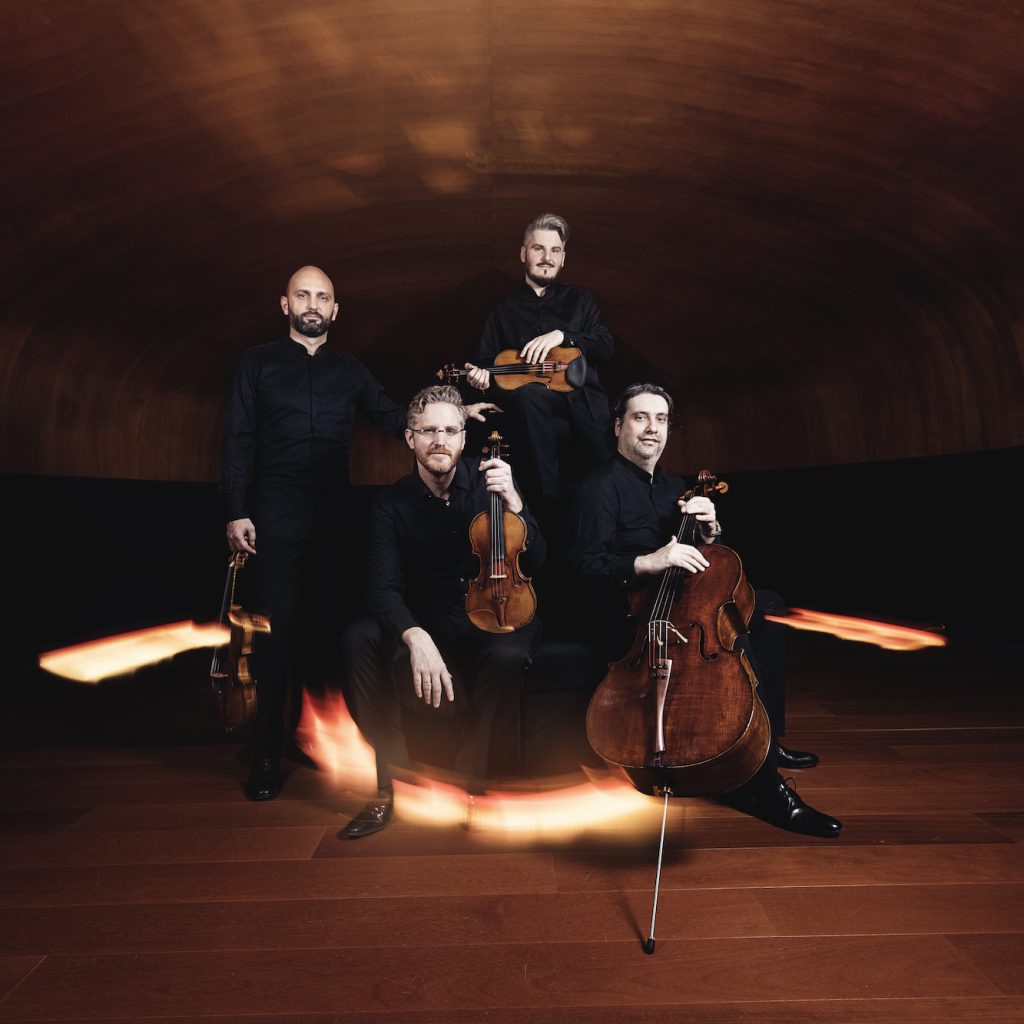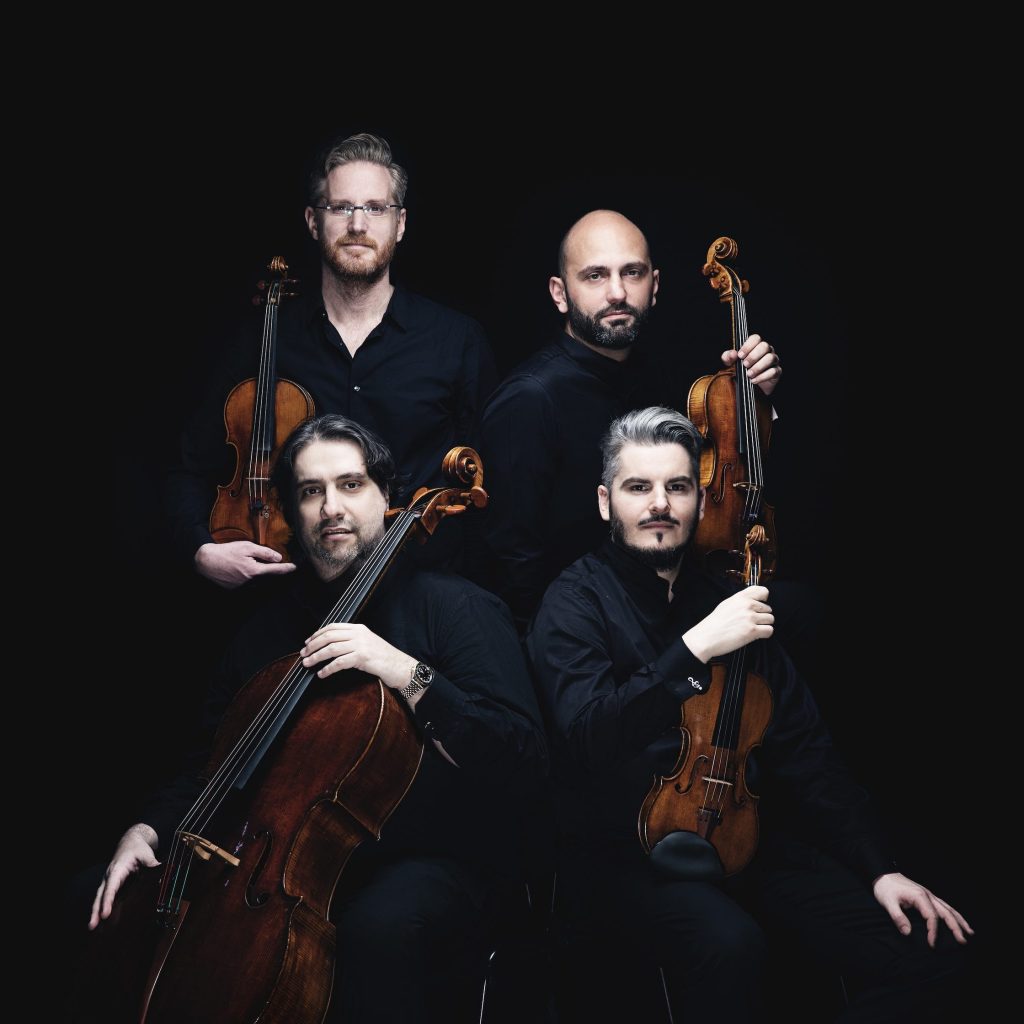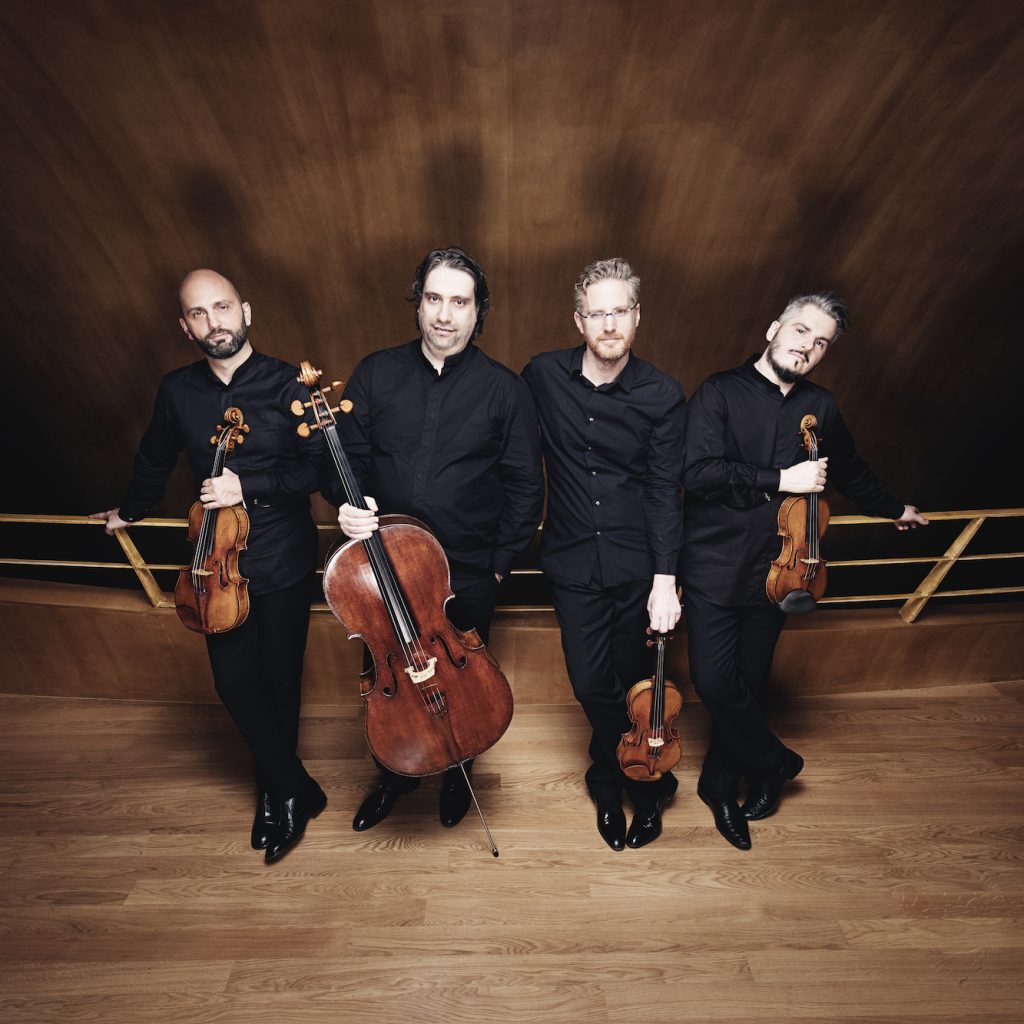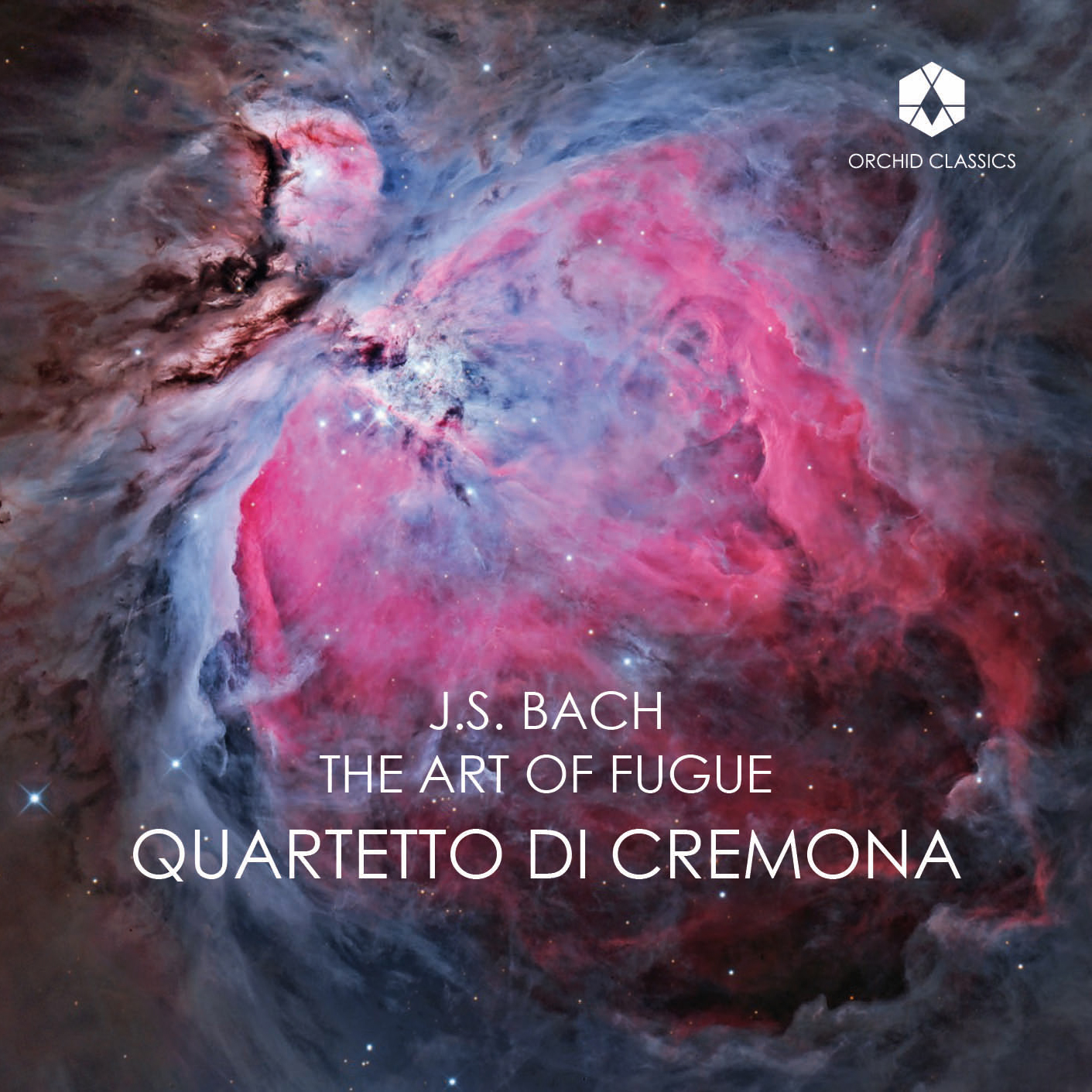This new release from the renowned Quartetto di Cremona brings a fascinating and multi-dimensional approach to J.S. Bach’s Art of Fugue, with innovative instrumentation creating a new interpretation of the Baroque master’s seminal work.



JOHANN SEBASTIAN BACH (1685-1750)
The Art of Fugue, BWV 1080
performed on eight instruments
1. Contrapunctus 1
Violin I, Violin II, Viola I, Cello
2. Contrapunctus 2
Violin, Viola II, Tenor Viola, Cello
3. Contrapunctus 3
Violin I, Violin II, Tenor Viola, Cello
4. Contrapunctus 4
Violin I, Violin II, Tenor Viola, Cello
5. Canon per Augmentationem in Contrario Motu (Canon 14)
Violin I, Cello
6. Contrapunctus 5
Violin I, Violin II, Viola I, Cello
7. Contrapunctus 6, a 4, in Stylo Francese
Violin I, Viola II, Viola I, Cello
8. Canon in Hypodiatesseron al roverscio e per augmentationem,
perpetuus (Canon 14a)
Violin II, Cello
9. Contrapunctus 7, a 4, per Augmentationem et Diminutionem
Violin I, Viola II, Viola Tenor, Cello
10. Contrapunctus 8, a 3
Violin I, Viola I, Cello
11. Canon alla Ottava
Violin II, Soprano Recorder
12. Contrapunctus 9, a 4, alla Duodecima
Violin I, Violin II, Viola I, Cello
13. Contrapunctus 10, a 4, alla Decima
Violin I, Violin II, Viola Tenor, Cello
14. Contrapunctus 11, a 4
Violin I, Viola I, Viola II, Cello
15. Canon alla Decima Contrapunto alla Terza
Violin I, Tenor Recorder
16. Contrapunctus 12a, a 4 rectus
Violin I, Viola I, Viola II, Cello
17. Canon alla Duodecima in Contrapunto alla Quinta
Violin I, Viola II, Viola Tenor, Cello
18. Contrapunctus 13a, a 3 rectus
Violin I, Viola I, Cello
19. Contrapunctus 13b, a 3 inversus
Violin II, Viola I, Cello
20. Canone alla duodecima in contrapuncto alla quinta
Violin II, Cello
21. Contrapunctus 18 (incomplete)
Violin I, Viola II, Viola I, Cello
Quartetto di Cremona
Most classical music lovers know – or at least know of – J.S. Bach’s The Art of Fugue. It’s sometimes described as the composer’s greatest creation, and spoken about in terms of its mathematical beauty, purity of musical thought, and thematic complexity. But strikingly, none of these descriptions tell us very much about what the music actually sounds like – or indeed what The Art of Fugue is, and who it’s for.
In 1742, the year of his fifty-seventh birthday, Bach made neat copies of twelve fugues and two canons. There was not yet a title to the set, and sketches suggest that these pieces were written first as a keyboard score, everything squashed onto two staves. Over the next few years Bach revised, expanded and added to this collection – and by the later 1740s he added a title to the newly-shaped volume: ‘Die Kunst der Fuge’. Now the music was written out not on two staves, to be grasped by a keyboardist’s hands, but on four: these were exercises in complex counterpoint, various ‘voices’ imitating and exchanging musical ideas, and so each voice was granted its own line. Bach oversaw publication proofs of the opus towards the very end of his life, but he didn’t live to see the whole in print. In 1751, the year after his death, Bach’s son Carl Philipp Emanuel advertised the published score via subscription – but it sold so badly that he was eventually forced to withdraw the edition. The copper engraver’s plates were worth more as metal than as music, and even a new edition with a magnificently PR-savvy introduction by the composer Friedrich Wilhelm Marpurg failed to drum up much trade.
So what is the purpose of this mysterious sequence of ‘contrapuncti?’. Broadly speaking, The Art of Fugue is a wordless instruction manual, a virtuosic demonstration of how to write counterpoint of different kinds. Bach uses a single theme in a single key and puts it through a series of increasingly complicated permutations: the theme is turned upside down, back to front, the note lengths halved or doubled, extra themes are added, and so on. Four canons sit alongside thirteen fugues that Bach labels ‘Contrapunctus’ in each case (hinting that the techniques he has applied can be used for any kind of counterpoint scenario, not just strict fugues). The final number, ‘Fugue with 3 subjects’, is unfinished, but incorporates Bach’s surname spelled out in German note names: B [B flat] – A – C – H [B natural].
All of which is fascinating and musically rich, of course… but what does this mean for performers wishing to turn this ingenious instruction book into a concert or a recording? When they decided to feature Bach’s work as part of their 25th anniversary celebrations, the Quartetto di Cremona had to give this some serious thought. ‘An audience could get bored,’ acknowledges Cristiano Gualco, the quartet’s leader. ‘Always the same sound, the same tonality, the same material – and so we realised we had to play it in a way in which the sound is really changing throughout.’ The solution came about in part through necessity. Since the Art of Fugue wasn’t written with a string quartet in mind, the inner lines in several of the movements go beyond the ranges of the second violin and viola. The solution? ‘Paolo, our second violinist, learned viola for these movements, and Simone, who plays the viola, had a tenor viola made. I knew also that Simone played the recorder very well.’ So rather than performing with just four instruments, the quartet uses seven instruments in total across the piece. And, Cristiano smiles, ‘as a coup de theatre we leave the instruments onstage before we come on for a concert. Sometimes we even hide the recorder.’
The impact of having such timbral variety is striking – as is the astonishing variety of sounds that the players conjure from their instruments. Contrapunctus I is mellow and broad; later numbers are pointed and bouncing; one (Contrapunctus V) is made to sound like a pipe organ. Cristiano talks about the ensemble’s experiments with conjuring the sounds of woodwind instruments, voices, and even playing ‘as if with mutes’ without actually using the devices. When the traditional quartet middle voices are replaced by viola and tenor viola (which has a lower-pitched set of strings than a standard viola), the overall sound becomes darker and creamier; by contrast, Simone Grammaglia’s recorder playing brings the quality of bright birdsong to the Canone all’ottava (the lines one octave apart), and a smooth melancholy to the Canone alla decima in contrapuncto alla terza (the players a tenth apart, before Bach turns one line upside-down for the second half of the movement).
‘If you study Bach as a child,’ Cristiano reflects, ‘you come to think it’s very strict. But actually there’s a lot of freedom. This became apparent too from speaking to many excellent Baroque specialists: there is space to find your own tempo, dynamics, articulation.’ The scores of these pieces, in other words, are satisfyingly blank in their four-voice form, and the quartet were able to bring their ideas to bear on a phrase-by-phrase level. This, in combination with their instrumental flexibility, allowed them to think about how best to shape the whole for listeners. ‘We tried to make it more captivating, let’s say.’ The Contrapuncti appear in the order printed in the first edition of 1751: indeed, Bach’s sequence includes a dazzling array of different rhythms and meters that allow for varied moods and tempi. The four Canons in the collection have then been split up and spread out by the quartet to ensure variety. ‘If you listen from the beginning to the end of the disc,’ Cristiano promises, ‘there should be a little story, is the idea.’
And that story is present, in a slightly different form, on the cover of the album: a photograph of the Great Orion Nebula taken by Cristiano, who spent much of the 2020 Covid pandemic learning the art and science of astrophotography. ‘In the Great Orion Nebula, so many things have happened and are happening, starting from chaos and finding order and returning to chaos. This constant metamorphosis is very much like our experience in The Art of Fugue, counterpoint after counterpoint. Some of them are simple, some so complicated that playing them we have the feeling that we got lost. But even in those cases the music resolves itself towards perfection and intelligibility.’
© Katy Hamilton
____________________
Notes from the Quartetto
Cristiano
One of the challenges we encountered when approaching the Art of Fugue was the knowledge that Bach didn’t write it for the purpose of performance. Almost an hour and a half of music based on the same material, and all in one key, D minor, required us to deliver it to an audience with even more variety and imagination than we would normally use for a standard string quartet piece.
Hence, we used six string instruments, following Simone’s idea, not only to avoid playing it as a string quartet adaptation and keeping the original lines (in many parts, the second violin and the viola parts go below the capacity of the instruments in the original version), but also to allow for much more variation of timbre throughout the piece, resulting in a string quartet where only the first violin and the cello kept their instruments for the entire time. Paolo and Simone continuously switched from their instruments to a viola, in the case of Paolo, and a tenor viola for Simone. Thus, we had the traditional two violins, viola, and cello string quartet sound, as well as violin, two violas, and cello; violin, viola, tenor viola, and cello; violin, second violin, viola, and cello; and two violins, tenor viola, and cello.
My own contribution towards an even larger variety of sound was remembering that Simone plays the recorder exceptionally well. I had the idea of including this instrument in two of the counterpoints (two duets) so that we could have a new sound not even belonging to the string instruments world. Thanks to Simone’s flawless playing, the results were very good.
The photo on the cover is mine. During the pandemic, while the quartet was kept far from the stage (as every musician everywhere was), I used my time to learn the extremely technical and complicated discipline of astrophotography, which I could never have approached without all the free time I suddenly had because of that tragic period. For months, I did nothing but study astronomy, got to know complicated software, and learn my way around using large and heavy equipment. To my huge surprise, one of my early space photos was noticed by NASA, which made it the Astronomy Picture of the Day on their site. Since then, I have continued learning and tried to find the time to spend many sleepless nights under the sky, no matter the cold winter temperatures. I have taken several pictures of beautiful objects that we cannot see with the naked eye but that are still there and always were (at least for thousands of years, sometimes much more).
Soon, I began to understand why I was so fascinated by my cosmic discoveries. The mathematical beauty behind what I was contemplating and photographing was somehow similar to what I always appreciated in music. Feelings and sentiments aside, of which some music is of course about, at the root of this art form is a mathematical structure that provides a frame and sometimes a “feeling” of abstraction, which is so present in Bach’s music, particularly in fugues.
Listening to the Art of Fugue is, for me, and I suspect for many, getting closer and closer to the absolute, to a higher form of understanding the symmetries and the order of the universe.
This picture, which I took last winter is of the famous Great Orion Nebula, a magnificent sky object, a star formation area in which so many things happened and are happening, starting from chaos, finding order and returning to chaos, in an (almost) never-ending metamorphosis, much like we experience in the development of the Art of Fugue, counterpoint after counterpoint. Some of them are simple, some so complicated that when playing them, we have the feeling that we got lost. But even in those cases, the music resolves itself towards perfection and intelligibility.
Paolo
Playing the viola in this project has been both an exciting educational experience and a challenge for me.
Although, from the first notes I played on the violin, I was surrounded by other musicians, including violists, I never paid much attention to this instrument. Even after many years of working in a quartet, closely with my colleague Simone (a violist), my curiosity was not piqued.
Only when it was decided to play and record J.S. Bach’s “The Art of Fugue” did I begin to really consider this instrument, which is not so different from the violin but has a decidedly different sound and size.
My dear friend, luthier Salvatore Scalia, had mentioned a viola he made and named “Delfino,” which he was very proud of. I asked if he could lend it to me for this project, and day by day I began to get acquainted with this unique and fascinating instrument, feeling an increasing connection with its deep and warm tone. The “Delfino” viola, which you can hear in the recording, eventually became mine; I was captivated by the quality of its timbre and the beauty of its sound.
Individual practice and musical approach in a quartet were not easy; being unaccustomed to the different sound and technique, I needed time to adjust and find a new balance as a violist within the musical structure of the piece.
Once I overcame the initial difficulties, I began to feel more comfortable playing the viola and to appreciate its expressive qualities. Nowadays, I study daily part of the solo viola repertoire to deepen my knowledge of the instrument and improve my proficiency.
Regarding a more specific description of the work faced during the study and preparation of “The Art of Fugue,” I want to highlight two aspects.
The first concerns reducing the adaptation time necessary to switch from a small and light instrument like the violin to the much larger and heavier viola. The exercise was especially useful for concerts where, unlike recordings, time is very tight, and there is no way to warm up on the instrument before performing.
The second aspect concerns understanding how to approach individual practice and adapt to the balance with the other instruments in the quartet, which in “The Art of Fugue” are very delicate and often fragile depending on the counterpoint.
Not all 18 counterpoints are suitable for the viola: only in the counterpoints where the violin’s lowest register is exceeded is it mandatory to use the viola to play the original notes. This was the main reason why, for this recording, we used more than the usual four instruments and why I often find myself switching from violin to viola and vice versa.
This is not easy, especially when we are on tour, but it is a difficulty for which I forgive Bach, as it has given me the opportunity to discover and appreciate an instrument of great charm that I had underestimated for too long.
Simone
Johann Sebastian Bach is a composer who has accompanied and fascinated me since childhood and has greatly conditioned the way I think about and conceive music.
For the 20th anniversary of the Quartetto di Cremona, and after having played much of the traditional repertoire and two important integrals such as those of Mozart and Beethoven, I began to think about what we could play to further evolve our thinking and our musical horizons. The Art of Fugue popped into my mind and soon became a constant thought. An absolute work that takes us back to the origins of “global” Western classical music, thanks to a genius who was able to make use of temperament proving that it could be an excellent and complete universal language.
Bach always manages to elevate listening beyond reason and emotion to bring performer and listener into a dimension of total transcendence, and he forces the musician to do the work of great depth and constant research necessary to make the best of his music.
The Art of Fugue for me is undoubtedly, to quote Wagner, his “GESAMTKUNSTWERK”, and therefore it was essential not to distort it with a transcription but to keep its structure intact. Here then is the explanation for the use of a viola and a tenor viola in addition to the traditional Quartet instruments (on the use of the two flutes my colleague will say).
In recent years we have been fortunate to perform the Art of Fugue in various places around the world, so this recording comes with a maturity that has grown over time and on the field. And it comes to crown 25 years of our career together.
I could not hope to celebrate them in a better way.
Giovanni
For all cellists, Bach’s 6 Suites represent a sort of Bible, a Sacred Text that one begins to leaf through with intimidation at a young age and never abandons.
Tackling The Art of Fugue in a quartet immediately inspired a certain fear, not just reverential. I found myself facing something new. I was no longer “alone,” and the distinct dances that had strongly guided my musical journey were no longer present. However, there was great enthusiasm in the commitment to characterize and make each counterpoint “unique,” almost giving it its own life.
Thus, differences in tempo, articulation, and the use of vibrato were added to the
mainstays of the past (frequent use of open strings and low positions, slurs of descending scale fragments), creating an interpretation that was convincing, at least to us.
I’m very pleased of the support that the four of us have given one another in this challenging project.
This new release from the renowned Quartetto di Cremona brings a fascinating and multi-dimensional approach to J.S. Bach’s Art of Fugue, with innovative approaches to instrumentation creating a new interpretation of the Baroque master’s seminal work.
The group substitutes in places a viola for the second violin, and a tenor viola in place of a standard instrument. Elsewhere, the violist takes up the recorder, with no less than eight instruments on stage lending a pioneering chorus-like nature to the work while preserving the original writing.
Since its formation in 2000, the Quartetto di Cremona has established a reputation as one of the most exciting chamber ensembles on the international stage. Regularly invited to perform in major music festivals and halls in Europe, North and South America and the Far East, they have garnered extraordinary acclaim during almost quarter of a century of performing.
Quartetto di Cremona
Since its formation in 2000, the Quartetto di Cremona has established a reputation as one of the most exciting chamber ensembles on the international stage. Regularly invited to perform in major music festivals and halls in Europe, North and South America, and Far East, they garner universal acclaim for their high level of interpretive artistry. Highlights of recent seasons include concerts at the Wigmore Hall (London), Concertgebouw (Amsterdam), Elbphilharmonie (Hamburg), Konzerthaus in Berlin, Brucknerhaus (Linz), in Geneva, Salzburg, Istanbul, Stockholm, Mumbai, Taipei, Beijing, for the Fundación Juan March in Madrid, at the Schubertiade in Schwarzenberg and at the Dvorak Festival in Prague. North American tours are regularly planned twice a year: the acclaimed debut at Carnegie Hall (October 2023) was followed by a re-invitation to Lincoln Center for the Chamber Music Society (February 2022, March 2024). In 24/25 season the ensemble will celebrate 25 years of career with several concerts at Italian major series, as well as in Spain, Switzerland, Germany, Netherlands, North America, Taiwan, Japan, and China. Previous recordings include: “Italian Postcards” (2020, Avie Records); a Schubert double CD (2019, Audite); the complete Beethoven String Quartets (2018, Audite). The Quartet is honorary citizen of Cremona, where they have been Professors at the Walter Stauffer Academy since 2011. Prized in 2019 with the “Franco Buitoni Award” by the Borletti Buitoni Trust for their constant contribution to the promotion of chamber music in Italy and around the world, they are ambassadors for the international project “Friends of Stradivari” and endorse Thomastik Infeld Strings.
Cristiano Gualco & Paolo Andreoli, violin
Simone Gramaglia, viola
Giovanni Scaglione, cello
quartettodicremona.com

Click the button above to download all album assets.

